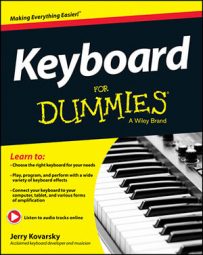The key to playing the keyboard is first knowing where to find C. Look at the black key groupings and find a group of two. The white key just below/to the left of the first black key in the group is the note C. Play it. Sounds nice, right?
Now go to every one of those white keys just below the group of two black keys and play them. They all sound nice and seem to be related to each other. You can play any of them together and they sound good. That’s because they’re all different versions of the same note, C. Some are higher sounding, and some are lower, but they’re all the note C.

On the full 88-key piano keyboard, the C note in the middle of the range is called (wait for it) middle C. A lot of keyboard instruction books use middle C as a starting place.
If you have a piano or 88-note keyboard, you can count the C notes starting at the bottom; this note is the fourth C you come to. That’s why another name for middle C is C4. This name comes in handy when you start using MIDI and when you have a keyboard with fewer than 88 keys.
Each grouping of notes starting with the C is called an octave. So the groups of two and then three black keys (plus the seven white notes) are an octave. That’s what the numbering system refers to: octave 1, octave 2, and so on.
A full piano keyboard (88 notes) has seven octaves plus a few extra notes on the bottom. Most other keyboards have even groupings of octaves (ranging from C to C): A 25-key controller has 2 octaves, 37 keys means 3 octaves, 49 keys has 4 octaves, 61 keys equals 5 octaves, and 73 keys means 6 octaves.
You sometimes see 32-key and 76-key keyboards; they have a few extra notes on the top or bottom of their ranges.

